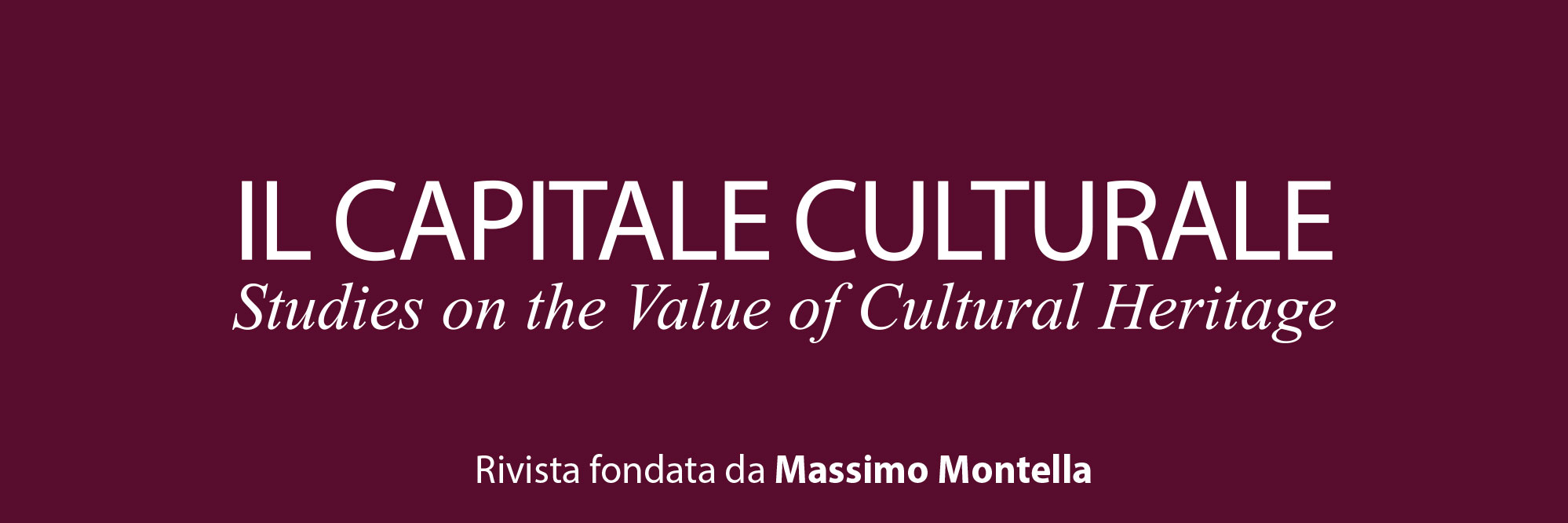Preserving the authenticity of food and wine festivals: the case of Italy
Downloads
Pubblicato
Fascicolo
Sezione
Licenza
Tutti i materiali pubblicati sono coperti da copyright, mantenuto dall'Università di Macerata che ne supporta finanziariamente e tecnicamente la pubblicazione.
La licenza adottata è la Creative Commons - Attribuzione/Condividi allo stesso modo. Ovvero, gli autori che pubblicano su questa rivista accettano le seguenti condizioni:
- Gli autori mantengono i diritti sulla loro opera e cedono alla rivista il diritto di prima pubblicazione dell'opera, contemporaneamente licenziata sotto una Licenza Creative Commons - Attribuzione che permette ad altri di condividere l'opera indicando la paternità intellettuale e la prima pubblicazione su questa rivista.
- Gli autori possono aderire ad altri accordi di licenza non esclusiva per la distribuzione della versione dell'opera pubblicata (es. depositarla in un archivio istituzionale o pubblicarla in una monografia), a patto di indicare che la prima pubblicazione è avvenuta su questa rivista.
- Gli autori possono diffondere la loro opera online (es. in repository istituzionali o nel loro sito web) prima e durante il processo di submission, poiché può portare a scambi produttivi e aumentare le citazioni dell'opera pubblicata.
DOI:
https://doi.org/10.13138/2039-2362/558Abstract
In the last ten years, the Academy has fostered the scientific debate over typical food products and their role in the development of rural communities and rural tourism. Background research define terroir as a harmonious bundle of territorial, climatic, historical and cultural characteristics which belong to a certain region. According to UNESCO, food and wine festivals are part of the intangible cultural heritage: during festivals product knowledge is spread among participants and local communities and local products become a powerful tool for disseminating the culture of a place. For many years in Italy there has been a growth in the number of food festivals: tourists in their journeys seek for authentic expression of local traditions and communities. Nevertheless, attracted by profits and by the availability of new demand, many actors have jumped into the business of culinary events and the outcome has been a proliferation of festivals who are not tied to the surrounding cultural heritage and offer products that do not originate from the area where events take place. This situation can damage seriously the territory by affecting its credibility, arming the carrying capacity, and by compromising the authentic tourism attractions and the exploitation of local economic resources by rural communities. This paper describes the recent case of the national agreement among public administrations, trade and hospitality associations and local farmers to develop some codes of practices to discipline the complexity of food and wine festivals, by adopting food safety principles and preserving environmental, historical and cultural authenticity.
Secondo l’UNESCO, i festival enogastronomici fanno parte del patrimonio culturale intangibile: durante questi eventi, la conoscenza del prodotto viene diffusa tra i partecipanti e le comunità locali e così i prodotti locali diventano uno strumento importante per divulgare la cultura di un determinato luogo. Per molti anni in Italia c’è stata una crescita nel numero di festival enogastronomici e nuovi attori, attratti dai facili profitti, sono entrati nel settore. Il risultato è stato la proliferazione di festival tutt’altro che “autentici”, dove vengono offerti prodotti non originari del luogo in cui l’evento si tiene. Questa situazione può danneggiare gravemente il territorio pregiudicandone la credibilità, alterandone la capacità di carico e compromettendo le attrazioni turistiche autentiche così come lo sfruttamento delle risorse locali da parte delle comunità rurali. Dopo aver introdotto il ruolo dei prodotti tipici (cibo e vino) nello sviluppo di un’esperienza turistica autentica, l’articolo descrive il recente caso dell’accordo nazionale tra pubbliche amministrazioni, associazioni del commercio e del turismo e organizzazioni di agricoltori per sviluppare alcune linee guida al fine di disciplinare la complessità dei festival enogastronomici, adottando rigidi principi di sicurezza alimentare e preservando l’autenticità culturale storica e ambientale dei luoghi.
Riferimenti bibliografici
Amit R., Schoemaker P. (1993), Strategic assets and organizational rent, «Strategic Management Journal», 14, n. 1, pp. 33-46.
Barney J.B. (1991), Firm resources and sustained competitive advantage, «Journal of Management», 17, n. 1, pp. 99-120.
Belletti G., Marescotti A., Scaramuzzi S. (2002), Paths of rural development based on typical products: a comparison between alternative strategies, in Farming and Rural Systems Research and Extension. Local Identities and Globalisation, Conference Proceedings of the Fifth IFSA European Symposium (Florence, April 2002), Firenze: Arsia, pp. 8-11.
Bérard L., Marchenay P. (1995), Lieux, temps, et preuves: la construction sociale des produits de terroir, «Terrain», 24, pp. 153-164.
Bessière J. (1998), Local development and heritage: traditional food and cuisine as tourist attractions in rural areas, «Sociologia Ruralis», 38, n. 1, pp. 21-34. Cammelli M. (2002), Il titolo V della costituzione e la fi nanziaria 2002: note, «Aedon. Rivista di arti e diritto online», n. 1.
Cavicchi A., Santini C., Beccacece E. (2010), Are you ready for the unexpected? The case of Brunello crisis, in Managing the Wine Business: research issues and cases, edited by M. Faraoni, C. Santini, Milano: McGrawHill, pp. 171-196.
Chhabra D., Robert H., Sills E. (2003), Staged Authenticity and Heritage Tourism, «Annals of Tourism Research», 30, n. 3, pp. 702-719.
Clifford C., Robinson R.N.S., Arcodia C. (2007), Searching for the authentic: Foodservice at a medieval banquet, in 3rd Tourism Outlook Conference in conjunction with Global Event Congress (Kuala Lumpur, Malaysia, 16-18 July 2007), edited by N. Othman, C. Arcodia, pp. 48-64.
Cohen E. (1988), Authenticity and commoditization in tourism, «Annals of tourism research», 15, n. 3, pp. 371-386.
Cole S. (2007), Beyond authenticity and commoditization, «Annals of Tourism Research», 34, n. 4, pp. 943-960.
Du Rand G.E., Heath E., Alberts N. (2003), The role of local and regional food in destination marketing: A South African situation analysis, «Journal of Travel and Tourism Marketing», 14, pp. 97-112.
Dyer J.H., Singh H. (1998), The Relational View: Cooperative Strategy and Sources of Interorganizational Competitive Advantage, «The Academy of Management Review», 23, n. 4, pp. 660-679.
Eisenhardt K.M. (1989), Building Theories from Case Study Research, «Academy of Management Review», 14, n. 4, pp. 532-550.
Getz D. (1994), Event tourism: Evaluating the impacts, in Travel, Tourism, and Hospitality Research: A Handbook for Managers and Researchers (2nd ed.), edited by J.R. Brent Ritchie, R.G. Charles, New York: John Wiley & Sons, pp. 437-540.
Getz D. (1998), Event tourism and the authenticity dilemma, in Global Tourism, edited by W.F. Theobald, Oxford: Butterworth-Heinemann, pp. 409-427.
Getz D. (2005), Event management and event tourism (2nd ed.), New York: Cognizant Communication.
Getz D. (2008), Event tourism: defi nition, evolution and research, «TourismManagement», 29, n. 3, pp. 403-428.
Gibbert M., Ruigrok W., Wicki B. (2008), What passes as a rigorous case study?, «Strategic Management Journal», 29, pp. 1465-1474.
Groves A. (2001), Authentic British food products: A review of consumer perceptions, «International Journal of Consumer Studies», 25, n. 3, pp. 246-254.
Hall C.M., Mitchell R.D. (2001), Wine and food tourism, in Special Interest Tourism: Context and
Cases, edited by N. Douglas, N. Douglas, R. Derrett, Brisbane: John Wiley & Sons, pp. 307-329.
Hall C.M., Sharples L. (2008), Food events, festivals and farmers’ markets: An introduction, in Food and Wine Festivals and Events around the World, edited by C.M. Hall, L. Sharples, Oxford: Elsevier, pp. 3-23.
Hamel G. (1991), Competition for competence and inter-partner learning within international strategic alliances, «Strategic Management Journal», Summer Special Issue, 12, pp. 83-103.
Hart C. (1999), Doing a literature review: Releasing the social science research imagination, London: SAGE Publications Ltd.
Hede A.M. (2008), Managing special events in the new era of the triple bottom line, «Event Management», 11, n. 1-2, pp. 13-22.
Hughes H.L. (2003), Marketing gay tourism in Manchester: new market of urban tourism or destruction of ‘‘gay space”?, «Journal of Vacation Marketing», 9, n. 2, pp. 152-163.
Huybers T., Bennett J. (2003), Inter-fi rm cooperation at nature-based tourism destinations, «Journal of Socio-Economics», 32, n. 5, pp. 571-587.
Jamal T., Hill S. (2004), Developing a framework for indicators of authenticity: The place and space of cultural and heritage Tourism, «Asia Pacifi c Journal of Tourism Research», 9, n. 4, pp. 353-371.
Laing J., Frost W. (2010), How green was my festival: Exploring challenges and opportunities associated with staging green events, «International Journal of Hospitality Management», 29, n. 2, pp. 261-267.
Larson I., Wikström E. (2008), Organizing events: managing confl ict and consensus in a political market square, «Event Management», 7, pp. 51-65.
Martinez M.G., Fearne A., Caswell J.A., Henson S. (2007), Co-regulation as a possible model for food safety governance: Opportunities for public-private partnerships, «Food Policy», 32, n. 3, pp. 299-314.
Montella M. (2012), Valore culturale, in Patrimonio culturale e creazione di valore, a cura di G.M. Golinelli, Padova: CEDAM, pp. 3-70.
Moscardo G., Pearce P.L. (1999), Understanding ethnic tourists, «Annals of Tourism Research», 26, n. 2, pp. 416-434.
Porter M.E. (1998), Clusters and the new economics of competition, «Harvard Business Review», 76, n. 6, pp. 77-90.
Richards G. (2002), Gastronomy: An essential ingredient in tourism production and consumption?, in Tourism and gastronomy, edited by A.M. Hjalager, G. Richards, London: Routledge, pp. 3-20.
Rotherham I.D. (2008), From Haggis to High Table – a Selective History of Festival and Feast as Mirrors of Landscape and Culture, in Food and Wine Festivals and Events around the World, edited by C.M. Hall, L. Sharples, Oxford: Elsevier, pp. 3-23.
Selwyn T. (1996), The tourist image: myths and myth making in tourism, New York: John Wiley & Sons.
Santini C., Cavicchi A., Canavari M. (2011), The Risk™ strategic game of rural tourism: how sensory analysis can help in achieving a sustainable competitive advantage, in Food, Agriculture & Tourism, edited by K.L. Sidali, A. Spiller, B. Schulze, Heidelberg: Springer, pp. 161-179.
Singleton S., Taylor M. (1992), Common property, collective action and community, «Journal of Theoretical Politics», 4, n. 3, pp. 309-324.
Wagner H.A. (2001), Marrying food and travel… culinary tourism, «Canada’s Food News», Foodservice Insights.
Wang N. (1999), Rethinking authenticity in tourism experience, «Annals of tourism research», 26, n. 2, pp. 349-370.
Wang Y. (2007), Customized authenticity begins at home, «Annals of Tourism Research», 34, n. 3, pp. 789-804.
Weiermair K., Bieger T. (2005), Tourism education in Austria and Switzerland: past problems and future challenges, in Global tourism higher education: past present and future, edited by C.H.C. Hsu, USA: Haworth Hospitality Press, pp. 39-60.
Yeoman I., Brass D., McMahon-Beattie U. (2007), Current issue in tourism: the authentic tourist, «Tourism Management», 28, pp. 1128-1138.
Yin R.K. (1994), Case Study Research. Design and Methods, Newbury Park: Sage.




